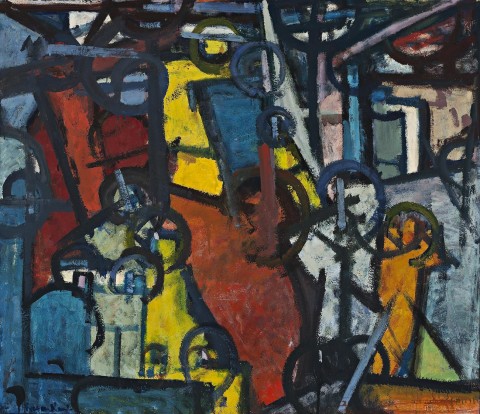THE SYMBOL, c.1960 – 62
ROGER KEMP
enamel on hardboard
105.0 x 122.0 cm
signed lower left: Roger Kemp
Private collection, Melbourne, acquired directly from the artist c.1975
Roger Kemp, Farmer’s Blaxland Gallery, Sydney, 22 August – 1 September 1962, cat. 32
Roger Kemp, Holdsworth Galleries, Sydney, 24 September – 14 October 1972, cat. 12
Roger Kemp, Mornington Peninsula Arts Centre, Victoria, 8 June – 1 July 1973, cat. 16
The Symbol, c.1960 – 62 comes to us from a watershed moment in modern Australian painting. Brimming with optimism, it directly speaks of that period when (supported by booms in industry, agriculture and mining) the nation was surging ahead industrially, scientifically, socially, and culturally. Indeed, The Symbol very much conveys the mood of the confident and progressive 1960s.
Artistically, Roger Kemp was a man of that moment. Following years of relentless studio toil, and placing work in every group exhibition that came his way, he had assumed the position of Melbourne’s pre-eminent abstract painter by the late 1950s. Besides mounting a successful solo show there at Gallery A in 1959, Kemp was a finalist in the by-invitation Helena Rubinstein Art Scholarship in mid-1960, then sparked controversy by winning the National Gallery of Victoria’s McCaughey Prize later the same year.
Then came his chance to break into Sydney. Stan de Teliga, director of the Farmer’s Blaxland Gallery there, made an offer. He wanted to fill his hall-like exhibition space with Kemp’s transcendentally-inclined abstractions. So, the artist spent nearly a year working up a massive show of fifty-two fresh compositions.
When it opened in early August 1962, Kemp’s art hit the Sydney contemporary scene for six. The critics were uniformly positive—a rarity for an interstate painter first showing in that city—applauding the hang as a commanding statement. ’His themes are big,’ wrote The Bulletin’s John Henshaw, ’and he is perfectly willing to delve until the right combination of symbols is forthcoming’.1
What impressed artists and curators was how this painter offered an alternative to the expressive abstractions of the prevailing Olsen-Passmore milieu. Where those artists favoured scratchy lines, roughened surfaces and earthen hues, Kemp suspended his forms in a firm scaffold of black strokes, enlivening each composition with a rich palette inclined to cool ultramarine-purple-crimson, sometimes adding discs of warm orange or solar yellow. And where the paintings of the Olsen-Passmore group were based in momentary expressionist release, Kemp carefully composed with symbols to suggest how modern man was scientifically, intellectually and spiritually evolving into a higher entity. Many detected strong similarities with the leading European abstractionist Alfred Manessier, and felt Kemp’s work to be boldly international in its character and ambition.
The Symbol was a key piece in that sumptuous exhibition, as indicated by its title. Technically, the painting typifies how Kemp worked in enamel on a firm panel. There were ready affinities to gothic decorative arts in this choice of media, and many viewers saw the prismatic effect of his abstractions as echoing mediaeval stained-glass windows. This conviction was behind the NGV later having three closely related pieces translated into majestic tapestries to be installed in its gothic-like Great Hall.2
In stylistic terms, we make out in The Symbol a dense crowd of figures standing behind a seeming pattern of interlocking circles, bars and arcs. These surface shapes are intended to refer to those hidden geometric and mathematical systems that govern our seemingly random universe, with colour used to indicate humanity’s progression from the darkness of brute ignorance (shadowy blue) across to knowledge and enlightenment (bright yellow).
So much was encapsulated in a single work—here it is in visual terms, the explanation to Kemp’s transcendental symbolism.
1. Bulletin, 8 September 1962
2. Heathcote, C., A Quest for Enlightenment: The Art of Roger Kemp, Macmillan, Melbourne, 2007, p. 165
DR CHRISTOPHER HEATHCOTE
